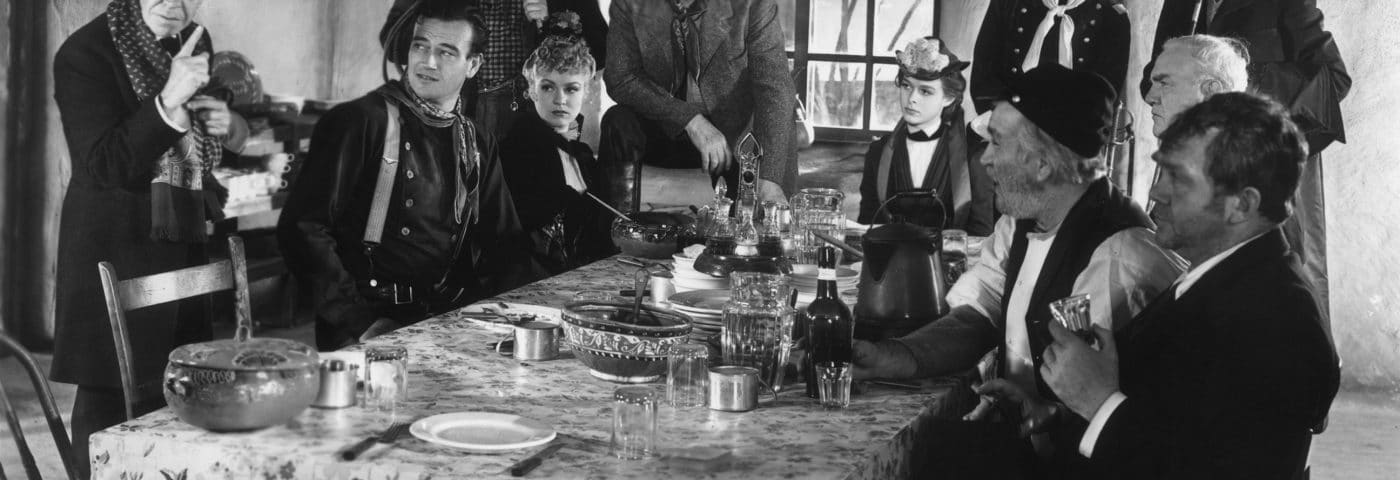Greatest Western of all time? Most influential Western? Archetypal Western? Stagecoach (1939) may be all three, depending on your point of view. John Ford hadn’t made a Western since 3 Bad Men (1926) and was eager to make another. Stagecoach was originally slated to be shot in Technicolor with David O. Selznick as the producer. Selznick wanted Gary Cooper to play the part of the Ringo Kid and Marlene Dietrich to play the part of Dallas. Ford disagreed, broke with Selznick, and teamed instead with producer Walter Wanger. Ford had already planned to cast John Wayne as the Ringo Kid. He cast Claire Trevor as Dallas.
Stagecoach was both a critical and financial success. Ford and screenwriter Dudley Nichols created a quintessential Western with easily understood moral distinctions that pit right against wrong and an underlying yearning for traditional open-sky freedoms. Yet it was also a subversive Western that turned the tables on many of the genre’s clichés. As Joseph McBride explains in his definitive Ford biography, Searching for John Ford, “Stagecoach literally was a political vehicle for Ford and Nichols, a way of looking at America’s past and present. This meta-Western can be read as a justification of American Manifest Destiny on the eve of World War II, a scathing critique of capitalistic corruption and Republican hypocrisy, and a celebration of the egalitarian values of the New Deal.”
McBride recounts the impish delight the pair displayed when they spoke with a New York journalist, just days before the opening:
“We’re particularly attached to this one,” said Nichols, “because it violates all the censorial canons.”
“There’s not a single respectable character in the cast,” declared Ford. “The leading man has killed three guys.”
“The leading woman is a prostitute,” Nichols added.
“There’s a banker in it who robs his own bank,” Ford noted.
“And don’t forget the pregnant woman who faints,” Nichols went on.
“Or the fellow who gets violently ill,” said Ford, referring to the drunken doctor.
From our perspective, Stagecoach looks and feels like a conventional Western expertly put together. There’s no fluff. Ford was famous for cutting out dialogue and expository scenes that weren’t absolutely necessary to the plot or the development of the characters. Even though his style was strikingly different from Ford’s, Orson Welles referred to Stagecoach as his “movie textbook.” Welles said he watched the film “over forty times” in order to learn how to make movies. While preparing to direct Citizen Kane (1941), he studied Stagecoach each night for more than a month, often accompanied by one or more of the technicians at RKO.
If you’re a fan of Hollywood movies from the 1930s and 1940s, don’t pass this one by. Even if you don’t care for Westerns, you’ll find this one rich in history with multi-dimensional characters real enough to walk out from the screen. That Ford was able to release both Stagecoach and Young Mr. Lincoln in 1939 was an incredible accomplishment, followed by The Grapes of Wrath and The Long Voyage Home in 1940, and How Green Was My Valley in 1941. With these and many other outstanding movies to his credit, Ford would become the greatest director in the history of film.
Stagecoach
(1939; directed by John Ford)
The Criterion Collection (Blu-ray and DVD)
Monday, February 10 at 8:00 p.m. eastern on Turner Classic Movies
I first posted this article here at my Classic Film Review website.

